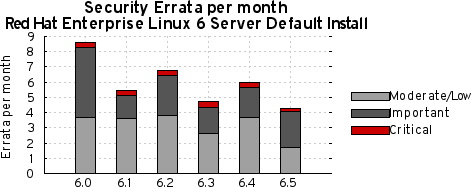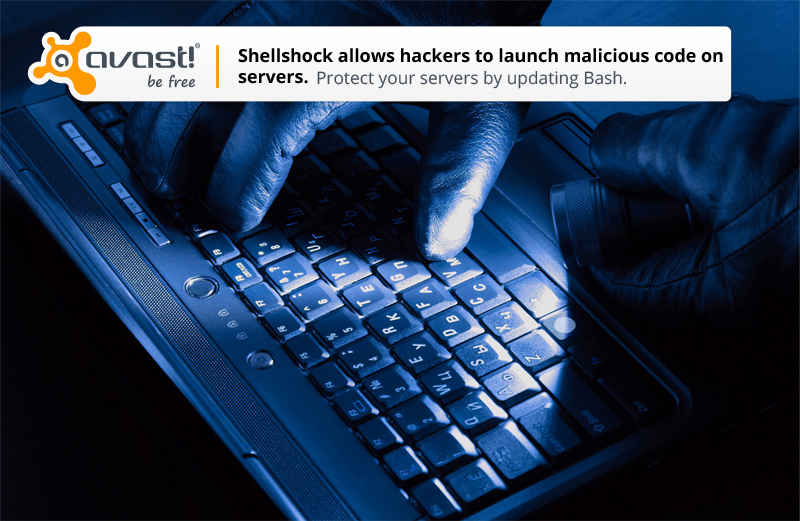Red Hat Enterprise Linux 6.6 was released the 14th of October, 2014, eleven months since the release of 6.5 in November 2013. So lets use this opportunity to take a quick look back over the vulnerabilities and security updates made in that time, specifically for Red Hat Enterprise Linux 6 Server.
Red Hat Enterprise Linux 6 is in its fourth year since release, and will receive security updates until November 30th 2020.
Errata count
The chart below illustrates the total number of security updates issued for Red Hat Enterprise Linux 6 Server if you had installed 6.5, up to and including the 6.6 release, broken down by severity. It’s split into two columns, one for the packages you’d get if you did a default install, and the other if you installed every single package.
During installation there actually isn’t an option to install every package, you’d have to manually select them all, and it’s not a likely scenario. For a given installation, the number of package updates and vulnerabilities that affected you will depend on exactly what you selected during installation and which packages you have subsequently installed or removed.
 For a default install, from release of 6.5 up to and including 6.6, we shipped 47 advisories to address 219 vulnerabilities. 2 advisories were rated critical, 25 were important, and the remaining 20 were moderate and low.
For a default install, from release of 6.5 up to and including 6.6, we shipped 47 advisories to address 219 vulnerabilities. 2 advisories were rated critical, 25 were important, and the remaining 20 were moderate and low.
Or, for all packages, from release of 6.5 up to and including 6.6, we shipped 116 advisories to address 399 vulnerabilities. 13 advisories were rated critical, 53 were important, and the remaining 50 were moderate and low.
You can cut down the number of security issues you need to deal with by carefully choosing the right Red Hat Enterprise Linux variant and package set when deploying a new system, and ensuring you install the latest available Update release.
Critical vulnerabilities
Vulnerabilities rated critical severity are the ones that can pose the most risk to an organisation. By definition, a critical vulnerability is one that could be exploited remotely and automatically by a worm. However we also stretch that definition to include those flaws that affect web browsers or plug-ins where a user only needs to visit a malicious (or compromised) website in order to be exploited. Most of the critical vulnerabilities we fix fall into that latter category.
The 13 critical advisories addressed 42 critical vulnerabilities across six different projects:
- An update to php RHSA-2013:1813 (December 2013). A memory corruption flaw was found in the way the openssl_x509_parse() function of the PHP openssl extension parsed X.509 certificates. A remote attacker could use this flaw to provide a malicious self-signed certificate or a certificate signed by a trusted authority to a PHP application using the aforementioned function, causing the application to crash or, possibly, allow the attacker to execute arbitrary code with the privileges of the
user running the PHP interpreter. - An update to JavaOpenJDK
- RHSA-2014:0026 (January 2014). Multiple improper permission check issues were discovered in the Serviceability, Security, CORBA, JAAS, JAXP, and Networking components in OpenJDK. An untrusted Java application or applet could use these flaws to bypass certain Java sandbox restrictions.
- RHSA-2014:0406 (April 2014). An input validation flaw was discovered in the medialib library in the 2D component. A specially crafted image could trigger Java Virtual Machine memory corruption when processed. A remote attacker, or an untrusted Java application or applet, could possibly use this flaw to execute arbitrary code with the privileges of the user running the Java Virtual Machine.
- RHSA-2014:0889 (July 2014). It was discovered that the Hotspot component in OpenJDK did not properly verify bytecode from the class files. An untrusted Java application or applet could possibly use these flaws to bypass Java sandbox restrictions.
- An update to ruby RHSA-2013:1764 (November 2014). A buffer overflow flaw was found in the way Ruby parsed floating point numbers from their text representation. If an application using Ruby accepted untrusted input strings and converted them to floating point numbers, an attacker able to provide such input could cause the application to crash or, possibly, execute arbitrary code with the privileges of the
application. - An update to nss and nspr RHSA-2014:0917 (July 2014). A race condition was found in the way NSS verified certain certificates. A remote attacker could use this flaw to crash an application using NSS or, possibly, execute arbitrary code with the privileges of the user running that application.
- An update to bash (Shellshock) RHSA-2014:1293 (September 2014). A flaw was found in the way Bash evaluated certain specially crafted environment variables. An attacker could use this flaw to override or bypass environment restrictions to execute shell commands. Certain services and applications allow remote unauthenticated attackers to provide environment variables, allowing them to exploit this issue.
- An update to Firefox:
- RHSA-2013:1812 (December 2013). Â Several flaws were found in the processing of malformed web content. A web page containing malicious content could cause Firefox to terminate unexpectedly or, potentially, execute arbitrary code with the privileges of the user running Firefox.
- RHSA-2014:0132 (February 2014). Several flaws were found in the processing of malformed web content. A web page containing malicious content could cause Firefox to crash or, potentially, execute arbitrary code with the privileges of the user running Firefox.
- RHSA-2014:0310 (March 2014). Several flaws were found in the processing of malformed web content. A web page containing malicious content could cause Firefox to crash or, potentially, execute arbitrary code with the privileges of the user running Firefox.
- RHSA-2014:0448 (April 2014). Several flaws were found in the processing of malformed web content. A web page containing malicious content could cause Firefox to crash or, potentially, execute arbitrary code with the privileges of the user running Firefox.
- RHSA-2014:0741 (June 2014). Several flaws were found in the processing of malformed web content. A web page containing malicious content could cause Firefox to crash or, potentially, execute arbitrary code with the privileges of the user running Firefox.
- RHSA-2014:0919 (July 2014). Several flaws were found in the processing of malformed web content. A web page containing malicious content could cause Firefox to crash or, potentially, execute arbitrary code with the privileges of the user running Firefox.
- RHSA-2014:1144 (September 2014). Several flaws were found in the processing of malformed web content. A web page containing malicious content could cause Firefox to crash or, potentially, execute arbitrary code with the privileges of the user running Firefox.
- RHSA-2014:1635 (October 2014). Several flaws were found in the processing of malformed web content. A web page containing malicious content could cause Firefox to crash or, potentially, execute arbitrary code with the privileges of the user running Firefox.
A flaw was found in the Alarm API, which allows applications to schedule
actions to be run in the future. A malicious web application could use this
flaw to bypass cross-origin restrictions.
97% of updates to correct 42 critical vulnerabilities were available via Red Hat Network either the same day or the next calendar day after the issues were public.
Previous update releases
We generally measure risk in terms of the number of vulnerabilities, but the actual effort in maintaining a Red Hat Enterprise Linux system is more related to the number of advisories we released: a single Firefox advisory may fix ten different issues of critical severity, but takes far less total effort to manage than ten separate advisories each fixing one critical PHP vulnerability.
To compare these statistics with previous update releases we need to take into account that the time between each update release is different. So looking at a default installation and calculating the number of advisories per month gives the following chart:
 This data is interesting to get a feel for the risk of running Enterprise Linux 6 Server, but isn’t really useful for comparisons with other major versions, distributions, or operating systems — for example, a default install of Red Hat Enterprise Linux 6 Server does not include Firefox, but Red Hat Enterprise Linux 5 Server does. You can use our public security measurement data and tools, and run your own custom metrics for any given Red Hat product, package set, timescales, and severity range of interest.
This data is interesting to get a feel for the risk of running Enterprise Linux 6 Server, but isn’t really useful for comparisons with other major versions, distributions, or operating systems — for example, a default install of Red Hat Enterprise Linux 6 Server does not include Firefox, but Red Hat Enterprise Linux 5 Server does. You can use our public security measurement data and tools, and run your own custom metrics for any given Red Hat product, package set, timescales, and severity range of interest.
